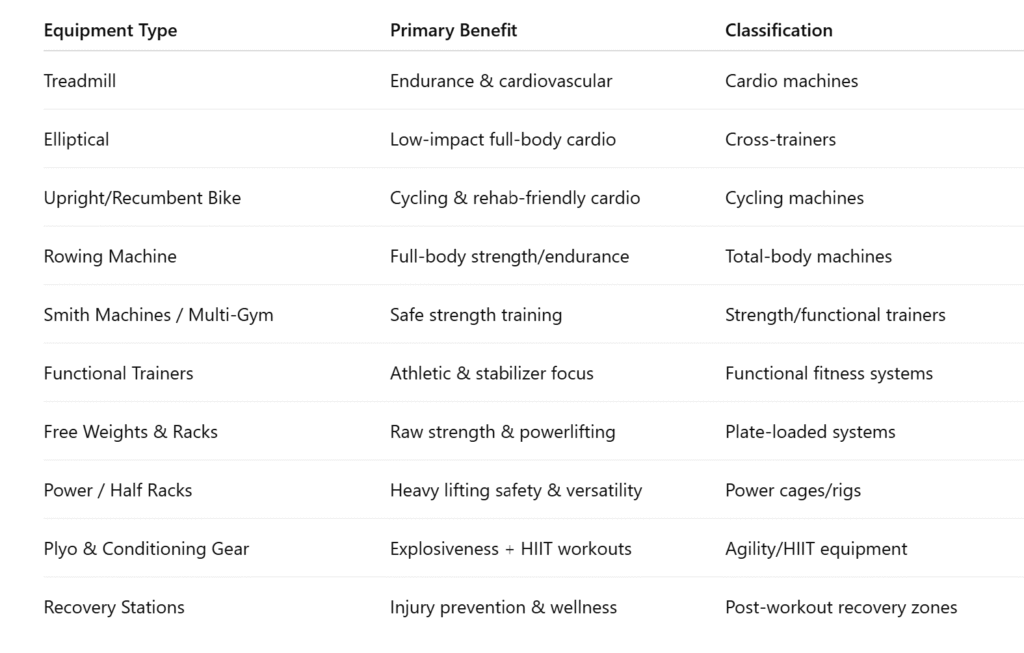1. Treadmills (Cardio Machines)
Treadmills remain the cornerstone of cardio training. From basic belt-and-motor models to advanced treadmills with incline and smart-tracking, these machines support heart-health, endurance building, and fat loss.
Types: manual, motorized, incline, decline-capable
Differentiators: shock absorption, interactive touchscreens, virtual running apps
Classifications: cardiovascular equipment, endurance gear, weight-loss segment
Benefits:
- Boosts cardiovascular fitness
- Safe and low-impact workout
- Offers customizable training programs
2. Ellipticals (Cross-Trainers)
Ellipticals have surged in popularity for their low-impact, full-body workouts.
- Types: compact, front-drive, center-drive, rear-drive
- Key Features: adjustable stride, upper-body arms, resistant levels
- Classifications: low-impact cardio, cross-training devices
Benefits:
- Reduced joint stress
- High-calorie burn with combined leg and arm motion
- Suited for all fitness levels
3. Upright & Recumbent Bikes
Stationary bikes remain indispensable for gyms, especially indoor cycling setups or therapy sections.
- Types: upright, recumbent, spin bikes
- Features: magnetic vs friction resistance, Bluetooth-enabled dashboards, heart-rate monitors
- Classifications: cycling machines, rehabilitation equipment
Benefits:
- Versatile cardio options
- Great for injury recovery and joint health
- Engaging features like on-screen coaches
4. Rowing Machines (Rowers)
Rowers simulate full-body rowing motion—a fusion of cardio and strength training.
- Types: air, magnetic, water-resistance rowers
- Distinguishing Features: real-row sensation, reports on stroke rate, meet RPE workout style
- Classifications: total-body training, high-intensity machines
Benefits:
- Full-body muscle engagement
- Targets arms, core, legs
- Compact footprint for space-saving gyms
5. Smith Machines & Multi‑Gyms (Strength Training)
These are staple commercial machines ideal for resistance and weight lifting.
- Types: Smith machines, cable crossovers, functional trainers
- Features: plate-loaded vs selectorized, multi-angle stations, safety catches
- Classifications: strength benches, plate-loaded systems, functional strength
Benefits:
- Safe for solo weightlifting
- Versatile for compound and isolation exercises
- Built for gradual progression and hypertrophy
6. Functional Trainers & Cable Stations
Functional training is essential for modern gyms, focusing on movement patterns over isolated muscles.
- Types: dual-pulley, kiting rigs, etc.
- Features: adjustable pulleys, attachments, TRX compatibility
- Classifications: functional fitness, cross-training systems
Benefits:
- Engages stabilizer muscles
- Supports varied athletic and rehabilitative movements
- Compact, modular gym install options
7. Plate‑Loaded Free Weights & Racks
A gym staple, free weights include barbells, dumbbells, and kettlebells.
- Types: olympic plates, dumbbells, bumper plates
- Features: solid steel construction, ergonomic grips, color-coded plates
- Classifications: free-weight systems, strength and hypertrophy gear
Benefits:
- Encourages natural, stabilizer muscle use
- Scalable from beginner to advanced
- Ideal for powerlifting, bodybuilding, functional movement
8. Power Racks & Half Racks
Power racks offer a safe framework for heavy lifting, essential for modern strength zones.
- Types: full-size squat cages, half racks, rig systems
- Features: safety bars, pull-up attachments, band pegs, Olympic-sized
- Classifications: strength cages, powerlifting rigs
Benefits:
- Safety-first environment for heavy lifts
- Multifunctional zones: squats, presses, pull-ups
- Scalable additions: dip bars, monkey bars
9. Plyometric & Conditioning Equipment
These are key for explosive training, agility drills, and high-intensity interval training (HIIT).
Types: plyo boxes, agility ladders, battle ropes, sleds
Features: varying heights, modular designs, durable grips
Classifications: functional trainers, HIIT gear, agility systems
Benefits:
Boosts speed, power, athletic performance
Highly versatile for group classes or individual sessions
Compact and stackable for gym space efficiency
10. Recovery & Stretching Stations
Recovery has gained prominence—dedicated zones elevate the gym experience.
- Types: foam roller stations, cable-assisted stretch rigs, massage chairs
- Features: ergonomic padding, traction handles, rehab-grade construction
- Classifications: post-workout recovery, flexibility enhancement
Benefits:
- Supports post-training recovery
- Elevates gym service offerings
- Helps reduce injury and improve mobility
2025 Trends: What’s Driving the Best Gym Equipment?
A. Smart, Connected Fitness
Connectivity is now standard. Expect Bluetooth, Wi‑Fi, integrated screens, and app ecosystems across most cardio and strength platforms.
B. Modular Multi‑Functional Systems
Gyms want dynamic configurations machines that support cross‑training and space optimization with adjustable stations and expandable rigs.
C. Robust Durability for High Throughput
Industrial-grade frames, reinforced welds, 600 lb+. capability, and military-grade plating ensure reliability in high-traffic gyms.
D. Recovery & Wellness Integration
Wellness zones are integrated: massage chairs, percussion therapy, heat-therapy foam rollers, and compression booths enhance member retention and satisfaction.
E. Holistic Programming & Content
Equipment now often includes curated training content on demand classes, form tracking, community challenges to increase engagement and motivation.
How to Choose the Right Equipment
Define Gym Audience & Goals
Are you targeting athletes, casual exercisers, rehab clients, or HIIT enthusiasts?
Check Space, Power & Layout
Machines need power hookups, floor space, airflow, and safe traffic flow.
Seek Quality & Warranty
Opt for commercial-grade brands offering 5+ year structural warranties and accessible parts/service.
Choose Equipment with Connectivity
Machines that integrate with apps (e.g., MyFitness, GymMaster, Zwift) boost value and loyalty.
Plan for Expansion
Select modular racks or functional systems that allow future add-ons like dip stations or cardio towers.
Summary Table of Equipment Types

Final Thoughts
In 2025, a modern gym’s success depends on blending cardio powerhouses, strength innovations, functional systems, and recovery tech. By choosing top-tier commercial equipment—spanning treadmills to plyo gear—you create an environment that meets member needs while promoting safety, engagement, and results.
Investing in connected, durable, and versatile equipment builds a space that stands out in capability and member satisfaction. Whether you’re launching a boutique studio or modern fitness center, this top 10 list equips you for the future of fitness.


